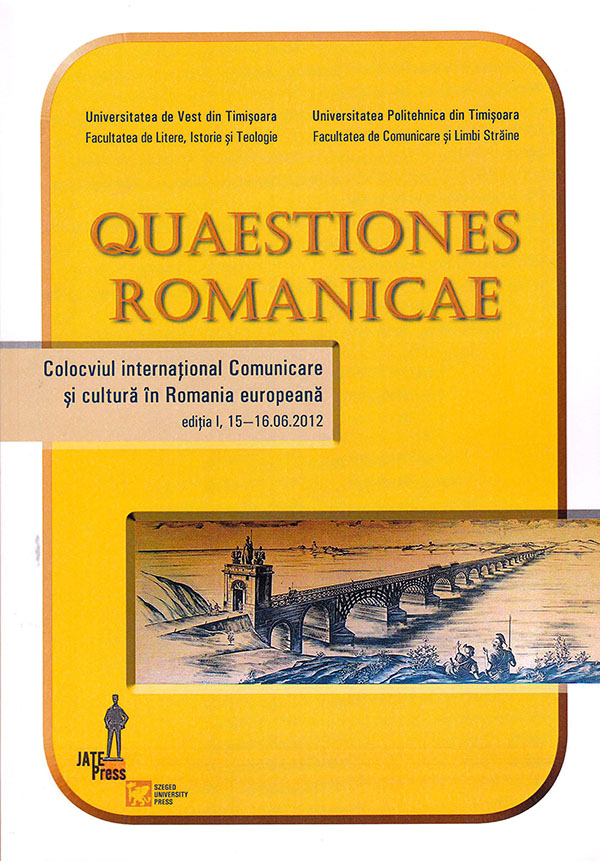Formule literare utilizate de scaunul de judecată din Comitatul Timiş, pentru mandatarea oamenilor comitatului sau a juzilor nobiliari, în sec. XIV – XV
Abstract: (Diplomatic Formulas in 14th -15th Century Legal Documents in the Timis County) In the study of regional history, researching administrative and legal institutions may provide valuable insight into the details of the whole of provincial life. This can only be accomplished by resorting to written and unwritten historical sources. In the medieval counties, one of these institutions was the judicial court. The present study focuses on a particular type of document which mandated those who were sent to undertake certain judicial tasks, mostly field investigations. The ones responsible for fulfilling these duties where the noblemen’s judges and the ‘people of the county’. The difference between the two institutions is significant, since the judges were elected by the noblemen of the county and represented them, while the ‘people of the county’ were noblemen or other categories of people who were employed by the court, and their duties were limited to undertaking investigations or summons. The analysis of the diplomatic formulas and of the structure of the documents enables us to conclude that the local clerks and notaries systematically used several sets of standards. The existence of notaries, on the other hand, is difficult to establish. We have no information on any notary in the Timiș county, and hence we do not know who was responsible with drawing up documents, but the identification of certain distinct models of writing and their evolution in time allows us to draw certain conclusions, even regarding the individual activity of some clerks.
Keywords: Regional History, Middle Age, Timiș County, noblemen.
Rezumat: Pentru studiul istoriei regionale, cercetarea instituţiilor administrative şi juridice reprezintă componenta esenţială a metodologiei de lucru. Cunoaşterea şi definirea unităţilor administrative constituie mijlocul prin care întreaga viaţă provincială poate fi reconstituită în cele mai mici amănunte. Desigur, acest lucru este posibil doar prin intermediul unor izvoare scrise sau nescrise. În rândul instituţiilor provinciale se regăsesc, alături de comitate, scaunele de judecată şi alte foruri juridice. Dintre acestea doar ultimele emiteau documente ca parte a propriei activităţi, furnizând astfel informaţii despre realităţile cotidiene. Atenţia noastră se concentrează asupra acelor acte ale scaunelor de judecată emise cu ocazia întreprinderii diferitelor misiuni, mai ales cercetări la faţa locului. Responsabili cu executarea acestor îndatoriri erau juzii nobililor şi oamenii comitatului. Pentru a face distincţia între cele două instituţii ale nobilimii provinciale se impune cercetarea terminologiei şi a expresiilor utilizate în documente. Dacă atributele judex nobilium şi homo noster sunt grăitoare în acest sens, unele documente folosesc câteva expresii pentru a menţiona mandatarea persoanelor responsabile cu îndeplinirea sarcinilor. În cazul comitatului Timiş s-au utilizat mai multe formule dactilografice, astfel că cei trimişi erau vnum/duos ex nobis sau per nobis deputato. Cert este că, de la sfârşitul deceniului trei al secolului al XIV-lea, aceştia îşi întăreau relatările prin depunerea sigiliului. Alternanţa expresiilor întâlnite ne poate duce cu gândul la existenţa unor notari, care şi-au desfăşurat activitatea în cadrul scaunului de judecată. În lipsa unor mărturii concrete, care să ateste funcţionarea acestora, nu excludem nici posibilitatea ca redactarea actelor să fi revenit unui membru al forului, fie el jude nobiliar sau vicecomite.
Cuvinte cheie: istorie regională, evul mediu, comitatul Timiș, nobilime.
